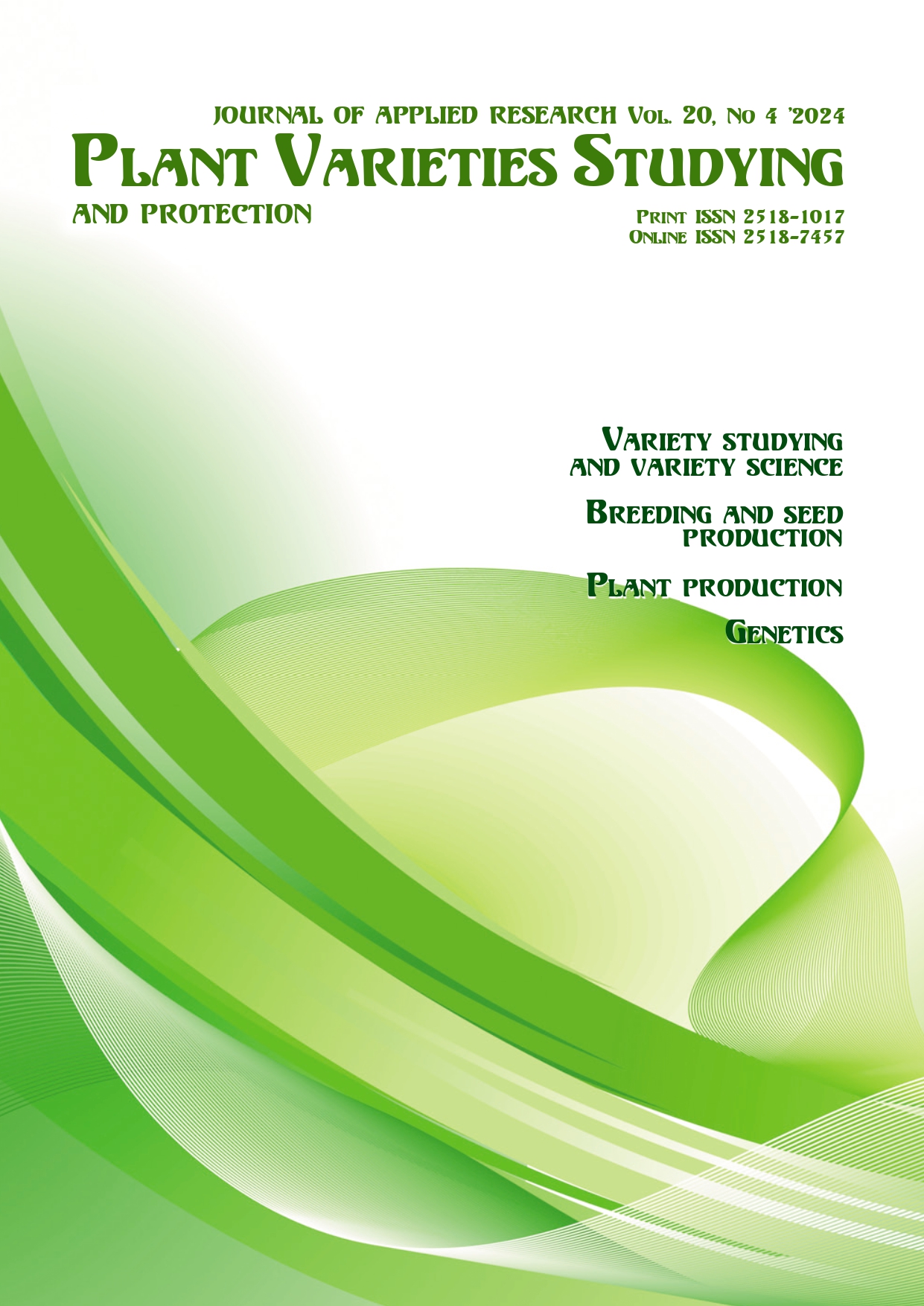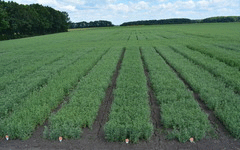Yield and Stability of New Medium-Maturing Potato Varieties (Solanum tuberosum L.) in the Forest-Steppe and Polissia Soil and Climatic Zones of Ukraine
DOI:
https://doi.org/10.21498/2518-1017.20.4.2024.321919Keywords:
qualification trial, yield, starch content, dry matter contentAbstract
Purpose. To carry out a comprehensive study and evaluation of new medium-maturing potato (S. tuberosum) varieties for yield, starch content and stability under the conditions of the Ukrainian Forest Steppe and Polissia. Methods. The qualification examination of potato varieties for their suitability for distribution in Ukraine (VSD) was conducted in 2021 and 2023 at eight research sites of the Ukrainian Institute for Plant Variety Examination located within the soil and climatic zones of the Forest-Steppe and Polissia. The area of the accounting plot was 25 m2, the location of the plots was randomised, replicated four times. Results. The economic and valuable characteristics of Ukrainian medium-maturing potato varieties – ‘Fanatka’, ‘Svitana’, ‘Marfusha’ and ‘Melaniia’, as well as foreign varieties – ‘TRIPLE7’, ‘Tiger’, ‘CAMELIA’ and ‘CARDYMA’ were analysed. The average yield of ‘Fanatka’, ‘Svitana’, ‘TRIPLE7’, ‘Tiger’, ‘CAMELIA’ and ‘CARDYMA’ in the Forest-Steppe was 3–12% higher than in Polissia. The maximum values of this indicator in both soil and climatic zones were shown by the varieties ‘Svitana’ (Forest-Steppe – 28.2 t/ha; Polissia – 26.0 t/ha) and ‘CAMELIA’ (Forest-Steppe – 29.3 t/ha; Polissia – 27.7 t/ha). In 2021, the highest average potato yield was obtained in the Forest-Steppe zone (23.3 t/ha); in 2023, in Polissia (21.1 t/ha). ‘Fanatka’ and ‘TRIPLE7’ varieties were more stable than ‘Svitana’, ‘Melaniia’, ‘CAMELIA’, ‘CARDYMA’, ‘Marfusha’ and ‘Tiger’, whose yields were highly dependent on the growing conditions. In terms of quality indicators, the best foreign varieties were ‘TRIPLE7’, ‘Tiger’ and ‘CARDYMA’. Their starch content was 15.6–17.8% in the Forest-Steppe and 17.1–18.1% in Polissia; dry matter – 23.9–25.8% in the Forest-Steppe and 25.4–25.8% in Polissia. Conclusions. According to the results of the VSD qualification test, the varieties ‘Fanatka’, ‘Svitana’, ‘Melaniia’, ‘TRIPLE7’, ‘CAMELIA’ and ‘CARDYMA’ are recommended for cultivation in the Forest-Steppe and Polissia zones; ‘Marfusha’ and ‘Tiger’ are recommended for Polissia only. According to qualitative indicators, the variety ‘TRIPLE7’ stood out with starch content of 17.8% in Forest-Steppe and 18.1% in Polissia; dry matter – 25.8% in both soil and climatic zones.
Downloads
References
Mialkovskyi, P. V., Bezvikonnyi, V. S., Kravchenko, A. O., & Yatsenko, А. О. (2020). Adaptive properties of different potatoes varieties in the conditions of the western Forest-Steppe. Bulletin of Uman National University of Horticulture, 2, 38–41. doi: 10.31395/2310-0478-2020-2-38-41 [In Ukrainian]
Singh, P., & Sandhu, A. S. (2023). Energy budgeting and economics of potato (Solanum tuberosum L.) cultivation under different sowing methods in north-western India. Energy, 269, Article 126755. doi: 10.1016/j.energy.2023.126755

Kui, L., Majeed, A., Ahmed, S., Khan, M. S. S., Islam, F., Chen, J., & Dong, Y. (2022). Solanum tuberosum (potato). Trends in Genetics, 38(11), 1193–1195. doi: 10.1016/j.tig.2022.06.013
 |
| 
Murniece, I., Karklina, D., Galoburda, R., Santare, D., Skrabule, I., & Costa, H. S. (2011). Nutritional composition of freshly harvested and stored Latvian potato (Solanum tuberosum L.) varieties depending on traditional cooking methods. Journal of Food Composition and Analysis, 24(4–5), 699–710. doi: 10.1016/j.jfca.2010.09.005

Krystyjan, M., Gumul, D., Areczuk, A., & Khachatryan, G. (2022). Comparison of physico-chemical parameters and rheological properties of starch isolated from coloured potatoes (Solanum tuberosum L.) and yellow potatoes. Food Hydrocolloids, 131, Article 107829. doi: 10.1016/j.foodhyd.2022.107829

Puzik, L. M., & Puzik, V. K. (2022). Comparative characteristics of culinary properties of potatoes. Vegetable and Melon Growing, 72, 79–89. doi: 10.32717/0131-0062-2022-72-79-88 [In Ukrainian]
Food and Agriculture Organization of the United Nations. (n.d.). Crops and livestock products. FAOSTAT. Retrieved from https://www.fao.org/faostat/en/#data/QCL
Vorobyova, N. V. (2016). Influence of bio preparations and plant growth regulators on the productivity of potato at the Right-bank of the Forest-Steppe of Ukraine. Vegetable and Melon Growing, 63, 65–73. [In Ukrainian]
Muravev, V. O., Melnyk, О. V., Semibratska, T. V., & Dukhina, N. H. (2019). Formation crop potatoes early in dependence from varieties. Vegetable and Melon Growing, 63, 245–249. [In Ukrainian]
Vitanov, O. D. (Ed.). (2022). Modern systems of vegetable production. Vinnytsia: Tvory. [In Ukrainian]
Baliuk, S. A., & Makliuk, O. I. (Eds.). (2015). The concept of organic farming (soil and agrochemical support). Kharkiv: Smuhasta Typohrafiia. [In Ukrainian]
Tang, J., Wang, J., Fang, Q., Wang, E., Yin, H., & Pan, X. (2018). Optimizing planting date and supplemental irrigation for potato across the agro-pastoral ecotone in North China. European Journal of Agronomy, 98, 82–94. doi: 10.1016/j.eja.2018.05.008

Wang, Y., Zhang, R., Li, S., Guo, X., Li, Q., Hui, X., Wang, Z., & Wang, H. (2024). An Evaluation of Potato Fertilization and the Potential of Farmers to Reduce the Amount of Fertilizer Used Based on Yield and Nutrient Requirements. Agronomy, 14(3), Article 612. doi: 10.3390/agronomy14030612

Vitanov, O. D., Honcharenko, V. Yu., Zelendin, Yu. D., Chefonova, N. V., Ivanin, D. V., & Uriupina, L. M. (2019). Adaptive systems of growing vegetables. Vegetable and Melon Growing, 65, 32–38. doi: 10.32717/0131-0062-2019-65-32-38 [In Ukrainian]
Ermantraut, E. R., Kyienko, Z. B., Matsiichuk, V. M., & Feshchuk, O. M. (2015). Ecological stability and plasticity of potato varieties in Polissia. Plant Varieties Studying and Protection, 3–4, 12–17. doi: 10.21498/2518-1017.3-4(28-29).2015.58412 [In Ukrainian]
Mthembu, S. G., Magwaza, L. S., Mashilo, J., Mditshwa, A., & Odindo, A. (2022). Drought tolerance assessment of potato (Solanum tuberosum L.) genotypes at different growth stages, based on morphological and physiological traits. Agricultural Water Management, 261, Article 107361. doi: 10.1016/j.agwat.2021.107361

Bondarchuk, A. A., & Oliinyk, T. M. (Eds.). (2020). Potato production: Breeding. Vinnytsya: Tvory. [In Ukrainian]
Grzesik, M., Janas, R., Steglińska, A., Kręgiel, D., & Gutarowska, B. (2022). Influence of microclimatic conditions during year-long storage of ‘Impresja’ potato tubers (Solanum tuberosum L.) on the emergence, growth, physiological activity and yield of plants. Journal of Stored Products Research, 99, Article 102033. doi: 10.1016/j.jspr.2022.102033

Mialkovskyi, R. O. (2017). Biometric indicators of potato plants depending on the variety, planting dates and depth of wrapping of tubers in the conditions of the Right-Bank Forest-Steppe of Ukraine. Vegetable and Melon Growing, 63, 250–256. [In Ukrainian]
Mykhailyk, S. M., Kyienko, Z. B., Sonets, T. D., & Smulska, I. V. (2023). The results of the assessment of new varieties of Solanum tuberosum L. according to the main economic and valuable characteristics depending on the soil and climatic zones of cultivation. Plant Varieties Studying and Protection, 19(1), 52–57. doi: 10.21498/2518-1017.19.1.2023.277771 [In Ukrainian]
Smulska, I. V., Topchii, O. V., Mykhailyk, S. M., Khomenko, T. M., Shcherbynina, N. P., & Skubii, O. A. (2023). The influence of soil and climatic conditions on the manifestation of economically valuable traits in different varieties of Helianthus annuus L. Plant Varieties Studying and Protection, 19(2), 118–125. doi: 10.21498/2518-1017.19.2.2023.282553 [In Ukrainian]
Furdyha, М. М. (2022). Adaptive ability and potential properties of potato varieties selected by the Institute for Potato Research NAAS. Agrarian Innovations, 12, 103–109. doi: 10.32848/agrar.innov.2022.12.16 [In Ukrainian]
Sonets, T., Kienko, Z., Mykhailyk, S., Syplyva, N., Gaidai, A., & Borodai, V. (2023). Study of the adaptability and resistance of potato genotypes to Fusarium solani (Mart.) Sac. Věda a Perspektivy, 12(31), 344–353. doi: 10.52058/2695-1592-2023-12(31)-344-353
Gherbawy, Y. A., Hussein, M. A., El-Dawy, E. G. A., Hassany, N. A., & Alamri, S. A. (2019). Identification of Fusarium spp. Associated with Potato Tubers in Upper Egypt by Morphological and Molecular. Genetics and Molecular Biology, 2(3), Article 107361. doi: 10.9734/ajbgmb/2019/v2i330062
Tymko, L. V., Furdyha, M. M., & Vermenko, Yu. Ya. (2018). Adaptive capacity of different potato varieties under the conditions of the Right-Bank Polissia of Ukraine. Plant Varieties Studying and Protection, 14(2), 224–229. doi: 10.21498/2518-1017.14.2.2018.134774 [In Ukrainian]
Koval, V. S. (2022). Adaptive ability of introduced potato accessions by yield capacity in Polissia region of Ukraine. Рlant Genetic Resources, 31, 8–19. doi: 10.36814/pgr.2022.31.01 [In Ukrainian]
Pysarenko, N., Sydorchuk, V., & Zakharchuk, N. (2022). Study of adaptive ability of potato varieties by the “yield” feature in the conditions of Central Polissia. Foothill and Mountain Agriculture and Stockbreeding, 71(1), 123–140. doi: 10.32636/01308521.2022-(71)-1-8 [In Ukrainian]
Pysarenko, N., Sydorchuk, V., & Zakharchuk, N. (2022). Еnvironmental plasticity, ultrastability and breeding value as a sign of yield of new potato varieties. Agriculture and Plant Sciences: Theory and Practice, 3, 91–101. doi: 10.54651/agri.2022.03.10 [In Ukrainian]
Pysarenko, N. V., Sydorchuk, V. I., & Zakharchuk, N. A. (2024). Evaluation of potato varieties for drought tolerance, ecological plasticity, adaptability, and consumer qualities at early stages of cultivation. Vegetable and Melon Growing, 74, 19–32. doi: 10.32717/0131-0062-2023-74-19-32 [In Ukrainian]
Kozhushko, N. S., Sakhoshko, M. M., Bashtovyi, M. G., Smilyk, D. V., Avramenko, V. I., & Dehtiarov, O. M. (2019). Prospects of practical use of new potatoes state varietal resources in the north-east Forest-Steppe of Ukraine. Bulletin of Sumy National Agrarian University. The Series: Agronomy and Biology, 4, 15–21. doi: 10.32845/agrobio.2019.4.3 [In Ukrainian]
Yatsenko, N., Ulianych, O., Yatsenko, V., Feshchenko, V., & Chubko, O. (2024). Adaptive variability of early potato in the Forest-Steppe of Ukraine. Ukrainian Black Sea Region Agrarian Science, 28(3), 67–77. doi: 10.56407/bs.agrarian/3.2024.67 [In Ukrainian]
Dahal, K., Li, X., Tai, H., Creelman, A., & Bizimungu B. (2019). Improving Potato Stress Tolerance and Tuber Yield Under a Climate Change Scenario – A Current Overview. Frontiers in Plant Science, 10, Article 563. doi: 10.3389/fpls.2019.00563
 |
| 
Jennings, S. A., Koehler, A.-K., Nicklin, K. J., Deva, C., Sait, S. M., & Challinor, A. J. (2020). Global Potato Yields Increase Under Climate Change With Adaptation and CO2 Fertilisation. Frontiers in Sustainable Food Systems, 4, Article 519324. doi: 10.3389/fsufs.2020.519324

Tkachyk, S. O. (Ed.). (2016). Methods of conducting qualification tests of plant varieties for suitability for distribution in Ukraine. General part (4th ed., rev.). Vinnytsia: FOP Korzun D. Yu. [In Ukrainian]
Tkachyk, S. O. (Ed.). (2016). Methodology for examination of varieties of potato plants and groups of vegetable, melon, spicy-flavored plants for suitability for distribution in Ukraine (PSP). Vinnytsia: FOP Korzun D. Yu. [In Ukrainian]
Sych, Z. (2005). Characteristics of the coefficient’s stability signs in the dynamical series with different duration. Plant Varieties Studying and Protection, 2, 5–21. doi: 10.21498/2518-1017.2.2005.67439 [In Ukrainian]
Tkachyk, S. O. (Ed.). (2016). Methods of conducting qualitative examination of plant varieties for suitability for distribution in Ukraine. Methods for defining crop quality indicators (3rd ed., rev.). Vinnytsia: FOP Korzun D. Yu. [In Ukrainian]
Classifier of quality indicators of botanical taxa, the varieties of which undergo examination for suitability for distribution. (2019). Vinnytsia: FOP Korzun D. Yu. Retrieved from https://sops.gov.ua/uploads/page/vidanna/2019/1.pdf [In Ukrainian]
Downloads
Published
How to Cite
Issue
Section
License
Copyright (c) 2024 S. M. Mykhailyk, A. P. Ivanytska, I. V. Smulska, O. V. Topchii, Z. B. Kyienko, N. S. Orlenko

This work is licensed under a Creative Commons Attribution-ShareAlike 4.0 International License.
Starting in 2022, the copyright to the publication remains with the authors
Our journal abides by the CREATIVE COMMONS copyright rights and permissions for open access journals.
Authors, who are published in this journal, agree to the following conditions:
- The authors reserve the right to authorship of the work and pass the first publication right of this work to the journal under the terms of a Creative Commons Attribution License, which allows others to freely distribute the published research with the obligatory reference to the authors of the original work and the first publication of the work in this journal.
- The authors have the right to conclude separate supplement agreements that relate to non-exclusive work distribution in the form in which it has been published by the journal (for example, to upload the work to the online storage of the journal or publish it as part of a monograph), provided that the reference to the first publication of the work in this journal is included.

























 Ukrainian Institute for Plant Varieties Examination
Ukrainian Institute for Plant Varieties Examination  Селекційно-генетичний інститут
Селекційно-генетичний інститут Institute of Plant Physiology and Genetics of the National Academy of Sciences of Ukraine
Institute of Plant Physiology and Genetics of the National Academy of Sciences of Ukraine
 The National Academy of Agrarian Sciences of Ukraine
The National Academy of Agrarian Sciences of Ukraine